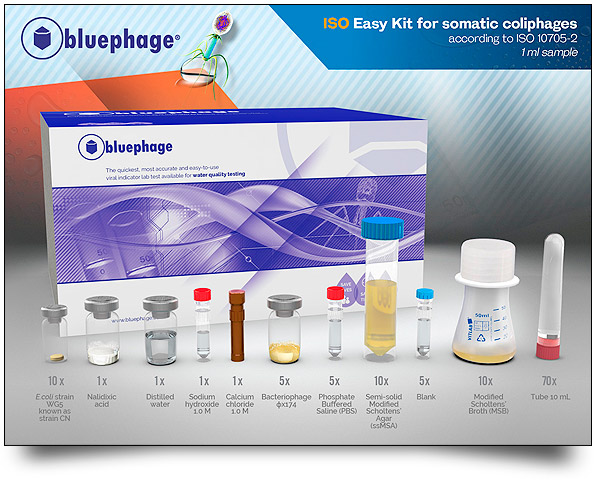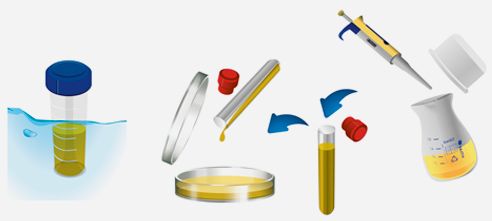ISO Easy Kit BP1601
For samples containing large numbers of bacteria. All types of water: raw and treated wastewater, surface water, recreational water, shellfish extracts, sediments and sludge extract after dilution where necessary.
ISO Easy Kits BP1601
For samples containing large numbers of bacteria.
All types of water: raw and treated wastewater, surface water, recreational water, shellfish extracts, sediments and sludge extract after dilution where necessary.

Bluephage Easy Kit for Enumeration of Somatic Coliphages
According to ISO 10705-2 – Double Agar Layer (DAL) method
Bacteriophage: Somatic Coliphages
Method: ISO 10705-2
Description
For samples containing large numbers of bacteria.
All types of water: raw and treated wastewater, surface water, recreational water, shellfish extracts, sediments and sludge extract after dilution where necessary.
ssMSA and MSB ready to use
Host strain (E.coli WG5) and positive control included (ɸX174)
Additional material required and not provided in the Kit:
• MSA powder media sold separately (catalogue no. BP1638)
• Sterile Petri dishes (90mm)

Application for the Easy Kit BP1601:
This quantitative detection kit is designed to specifically detect and enumerate somatic coliphages by incubating the sample with the appropriate host strain. The method is applicable to raw and treated wastewater, surface water, recreational water, shellfish extracts, sediments, and sludge extracts after dilution where necessary.
| PARAMETER | EXPECTED CONCENTRATION (PFU/100 ML) | ANALYSIS VOLUME | EASY KITS |
|---|---|---|---|
| Somatic coliphages Somatic coliphages 104-106 1 mL BP1601 | 104-106 | 1 mL | BP1601 |
| PARAMETER | EXPECTED CONCENTRATION (PFU/100 ML) | ANALYSIS VOLUME | EASY KITS |
|---|---|---|---|
| Somatic coliphages Somatic coliphages 102-104 1 mL BP1601 | 102-104 | 1 mL | BP1601 |
| PARAMETER | EXPECTED CONCENTRATION (PFU/100 ML) | ANALYSIS VOLUME | EASY KITS |
|---|---|---|---|
| Somatic coliphages Somatic coliphages 0-103 1-100 mL BP1601 | 0-103 | 1-100 mL | BP1601 |
| PARAMETER | EXPECTED CONCENTRATION (PFU/100 ML) | ANALYSIS VOLUME | EASY KITS |
|---|---|---|---|
| Somatic coliphages Somatic coliphages 0-104 1-100 mL BP1601 | 0-104 | 1-100 mL | BP1601 |
What is contained in the Easy Kit BP1601
This detection and enumeration kit is based on ISO 10705-2. It contains all the consumables and biological material required to perform the analysis, including freeze-dried specific host cells for the somatic coliphage group, which are ready for use after 120-150 min of incubation.
How to perform the coliphage test with the Easy Kit BP1601
The sample or the appropriate dilution is mixed with a small volume of semi-solid nutrient medium. The host strain culture is added and plated on a solid nutrient medium. After this, the incubation and reading of plates for visible plaques take place. The results are expressed as the number of plaque-forming units (pfu) per unit of sample volume.
Number of tests
This kit is designed to perform 70 assays with one 100 mL water sample in each one.

Application
Raw and treated wastewater, surface water, recreational water, shellfish extracts, sediments, and sludge extracts after dilution where necessary.
Sample volume: 1 mL
Number of assays: 70 assays
Product code: BP1601
What are coliphage viruses?
Somatic coliphages are bacteriophages of enteric origin that infect Escherichia coli through cell surface receptors. Somatic coliphages in a water sample usually indicate contamination by human or animal feces or sewage containing these excrements.
Why test for coliphages?
Bacteriophages offer complementary advantages to bacterial indicators. They tend to persist longer in the environment, and their resistance in water and food more closely resembles that of human enteric viruses than fecal viruses, thus providing more information about viral pathogens that are not adequately represented by studying bacterial indicators alone. Therefore, they are a relatively quick and simple method for detecting fecal contamination.
What regulations require the analysis of coliphages?
Somatic coliphages are included in water, wastewater, biosolids, and food guidelines and regulations, complementing bacterial indicators such as E. coli and enterococci.



